Diversity at NELSON: Celebrating Asian American & Pacific Island Heritage Month with Food
What better way to celebrate Asian American Pacific Islander Heritage Month than with food! Native cuisine is one the of many ways we express our cultures and share it with others. Although we can’t bring the food to life, we are living and learning vicariously through our Teammates. This month features stories from Keo Ballerstein, Carey Ann Ragusa, and Joy Wang as they show us what they love about Lao, Filipino, and Chinese cuisine.
Keo Ballerstein – Lao New Year Celebration!

This year, the Lao New Year celebration began on Thursday, April 14th and ended on Saturday, April 16th. This festive occasion is a 3-day national holiday in Laos that is filled with a variety of Lao traditions and customs.
Growing-up in the United States from a very young age, I recall the epic celebrations. My father, at the time, was the resident of the Lao American Association of Florida. It was important for him to bring the Lao community together, to not only celebrate, but to educate first-generation Lao Americans about the history and culturally significant traditions of Laos. Ethnic folk dances, folk stories, blessing ceremonies, community soccer matches, and the ultimate Kataw matches were some of the activities that brought the community together during the weekend-long celebration.
And then, there was the food…
Food from Laos has many influences within Southeast Asia. Thailand, Vietnam, and Cambodia play a part in some of the picy and savory dishes. But, the staple and comfort food in the Lao culture is sticky rice (kow niew).
The memory of waking-up to its sweet aroma engulfing the house when my mother prepared it before delicately frying it with eggs, brings me joy. I was the kid who joyfully walked to school with a fried kow niew patty in hand. “Breakfast for champions,” I was told.
While I may have a more sophisticated palate now and enjoy dishes from other cultures, I can honestly say that no cuisine leaves me more complete than kow niew with grilled chicken (ping gai), chicken salad (larb gai), green papaya salad (tham mak hoong), and spicy tomato sauce (jeow mak len).
I look forward to celebrating with family and friends again this year. While it may not be in a grand scale like in yearspast, passing down the Lao traditions to my daughter is a wonderful way to embrace a promising future.
Happy Lao New Year! (Sabaidee Pi Mai!)

Carey Ann Ragusa – A Filipino Feast
 I’m Filipino and the best part of being Filipino is the food and the family gatherings we have. My dad used to own a restaurant and used to cook so many different types of Filipino food and the family would come to the restaurant just to be together, sing Karaoke, and celebrate the little things. It would never just be the immediate family. There would always be the extended family with the cousins, the Titos and Titas, the Lola and Lolo and always plenty of food. We would have lumpia, pancit, halo halo, sisig, kare kare and crispy pata, and so many other things that are too much to name.
I’m Filipino and the best part of being Filipino is the food and the family gatherings we have. My dad used to own a restaurant and used to cook so many different types of Filipino food and the family would come to the restaurant just to be together, sing Karaoke, and celebrate the little things. It would never just be the immediate family. There would always be the extended family with the cousins, the Titos and Titas, the Lola and Lolo and always plenty of food. We would have lumpia, pancit, halo halo, sisig, kare kare and crispy pata, and so many other things that are too much to name.

Joy Wang – Boiled & Pan Fried Dumplings (Jiǎozi & Guotie) with homemade chili!
 One of the best things about dumplings is the history of family all wrapped up in one. Growing up, it was almost a right of passage to be able to help parents, grandparents, aunts, and uncles in preparing for something so simple but so steeped in traditions. Learning about the individual ingredients that make up the filling, observing, trying out the tried-and-true methods passed down from generations prior, and understanding that there isn’t just one way to make a dumpling, because every family has their own variations was the best. It’s a time best associated with everyone coming together no matter age, gender, or race to try their hand at folding, pleating, or crimping a delicious little bundle into all shapes and sizes. To be able to pass on these types of traditions, introducing new ones to others, and setting down work and the busyness of daily life to enjoy a meal that’s always brought family style is something I always look forward to. Feeding others is also a plus as well 😊
One of the best things about dumplings is the history of family all wrapped up in one. Growing up, it was almost a right of passage to be able to help parents, grandparents, aunts, and uncles in preparing for something so simple but so steeped in traditions. Learning about the individual ingredients that make up the filling, observing, trying out the tried-and-true methods passed down from generations prior, and understanding that there isn’t just one way to make a dumpling, because every family has their own variations was the best. It’s a time best associated with everyone coming together no matter age, gender, or race to try their hand at folding, pleating, or crimping a delicious little bundle into all shapes and sizes. To be able to pass on these types of traditions, introducing new ones to others, and setting down work and the busyness of daily life to enjoy a meal that’s always brought family style is something I always look forward to. Feeding others is also a plus as well 😊
Women of NELSON: Honoring Women In Architecture & Design
In honor of Women’s History Month, we’re connecting you with a handful of the women of NELSON who are boldly transforming our industry. Sharing their thoughts and perspectives, keep reading to learn more about what it means to be a woman in architecture and design and what inspires them each day:
Sheryl Moore-Marlette
Chief Operating Officer
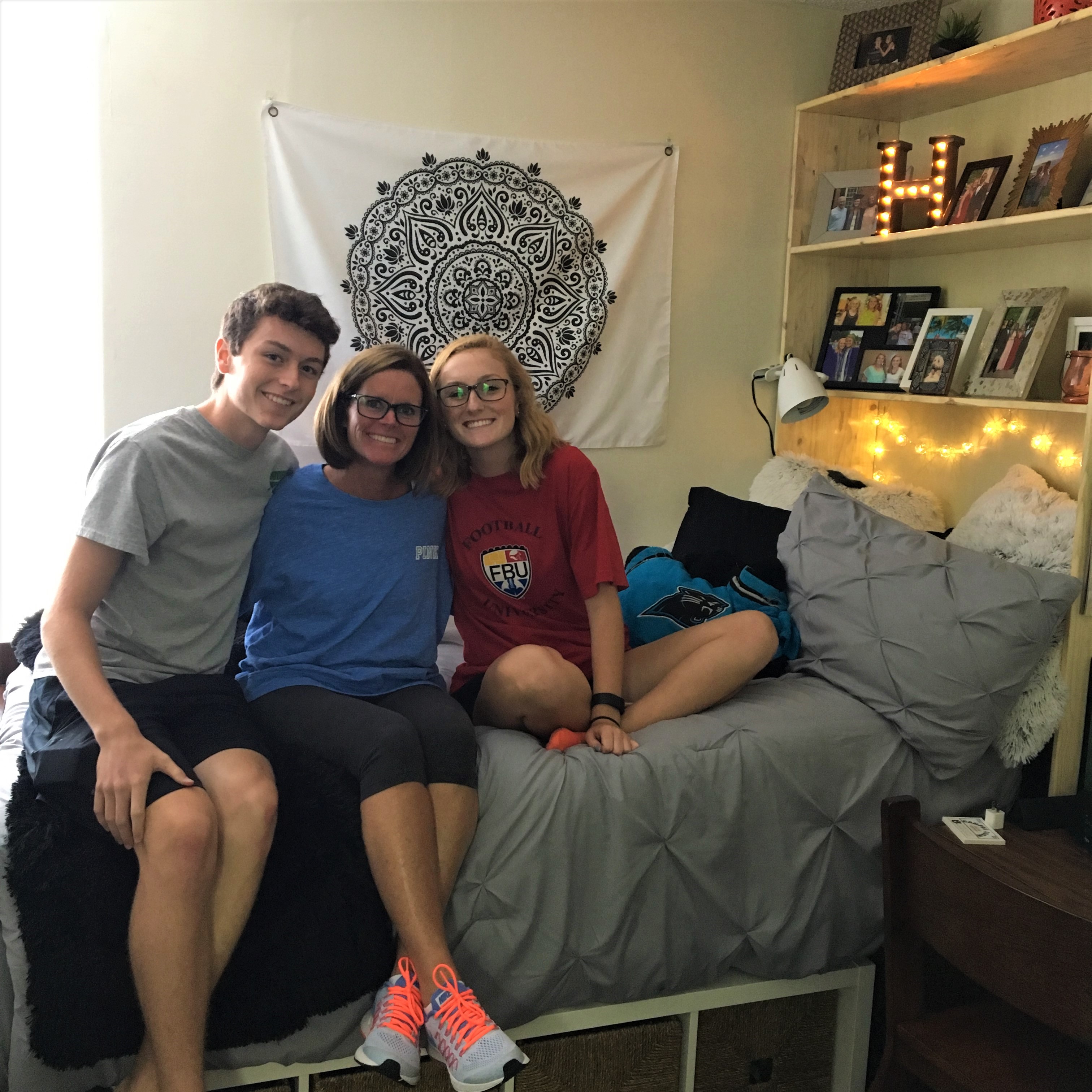
What lessons and experiences can you share as a female leader?
Women are naturally empathetic beings and great communicators who know how to rally a team together. I encourage women to use those powers for good. Improve yourself but don’t change everything about yourself — be the best version of YOU.
If you could give one piece of advice to young female professionals, what would it be?
Transferable skills are critical to professional success because they empower you to do your job, whatever it is, well. They increase your odds of success at any level and are the foundation and engines of propelling you forward — no matter what you do or how high you want to climb.
What do you want to be remembered for?
I want to be remembered for being authentic, dependable, trustworthy and always following my moral compass.
Susan Martens
SVP, Human Resources

If you could give one piece of advice to young female professionals, what would it be?
Aim and push yourself to GROW — both internally and externally. Don’t underestimate yourself, know when to be tenacious and when to step back and re-strategize. Listen and learn – it’s not always about being the “loudest” voice in the room, you can still be heard. Respect diversity and differences and have a trusted colleague you can talk things through.
What are some of the traits that you admire most amongst other female leaders you’ve worked with?
Aside from what you would expect from leaders being focused and possessing a clear vision, additional traits I admire most are a strong sense of fairness, loyalty, decisiveness, honesty, and humility. A sense of humor also works!
Past or present, name three women that you would invite over for a dinner party?
Condoleezza Rice, Ruth Bader Ginsberg, and my mother. All extremely intelligent women and what I value is integrity and conversations based on the value of merits – great dinner party!
Heesun Kim
Design Director

When did you first become interested in design/architecture?
I was a very lucky girl. My father is a wood sculptor and my mother is a Korean traditional flower artist. I naturally grow up surrounded by art & flowers…and I like to express my vision through drawings & objects for as long as I can remember. However, I ended up falling in love with design more than fine art. I realized that while fine art is focusing on self-expression, design focuses on a user. Because of this, this path was more meaningful to me.
If you could give one piece of advice to young female professionals, what would it be?
Embrace being a woman. Be confident of who you are and express your point of view. Do not limit yourself professionally because you are EQUAL. Empower the women around you and encourage an inclusive culture. Along the way, you’ll contribute to making the world a better place for all, and most importantly yourself.
Andrea Brandt, RID, IIDA, LEED AP ID+C, CMP
Studio Director

When did you first become interested in design/architecture?
I had planned to be an art teacher. However, I had a class in Home Economics my junior year in high school that piqued my interest in decorating…yes, decorating.
I went on a few campus visits and while at Iowa State University I accidentally found myself in the College of Design (Arch, ID, LA, GD, ID, RP, & Arts). I came back and visited the “shop” teacher and said, “can I take a side class in drafting instead of sitting in study hall?” I enrolled in Interior Design in 1981 and never looked back.
What lessons and experiences can you share as a female leader?
Transparency and vulnerability are necessary.
If you are going to pull up a chair, you need to be present.
Focus on elevating others.
Past or present, name three women that you would invite over for a dinner party?
“Nothing is worth more than laughter. It is strength to laugh and to abandon oneself, to be light” – Frida Kahlo
“Fight for the things that you care about, but do it in a way that will lead others to join you.” – Ruth Bader Ginsburg
“The next decade cannot be a decade of confrontation and contention. It cannot be East vs. West. It cannot be men vs. women. It cannot be Islam vs. Christianity. That is what the enemies of dialogue want.” – Benazir Bhutto
Cheryl Smith, AIA LEED AP
Director

When did you first become interested in design/architecture?
It was in my genes. As a child, I loved to draw and build things with my father and I remember going for drives with my parents to look at new buildings. It’s what I knew and loved to do. My father was an entrepreneur and construction owner; I learned a lot from him about the construction business and the development world. I also learned from my mother, who was the tastemaker of the family, how to design and become a leader in the community. I think that I found the best of both worlds because as an architect, I have a desire to create wonderful places for people, but also understand how projects get built that contractors can relate to.
If you could give one piece of advice to young female professionals, what would it be?
Get involved, especially with community groups, and own what you are doing. As a young designer, this is an excellent way to find mentors and as you gain more experience, it provides opportunities for you to become a mentor to others. In college, I became involved in the Architecture in the Schools program where an architectural student is paired with an architect to teach grade school children about architecture and the built environment. After graduating from college, I became an ACE Mentor and eventually joined the ACE Mentor Board. The experience becomes both a humbling and rewarding part of the growth of your career.
Chen Hui Spicer, NCIDQ
Southeast Global Solutions Regional Design Leader

When did you first become interested in design/architecture?
From a young age, my childhood dream was to become a famous artist (or die trying!) For a while, I knew I wanted to be a Fine Arts major in college but ultimately I decided that Interior Design was the right path financially. For me, I loved using art to express myself and enjoyed the ability it gave me to share my emotions beyond just words.
What lessons and experiences can you share as a female leader?
My advice is to always be supportive of other women. Also, be strong and bring your best self at all times. The positive energy that you give the world will come back to you.
When I was in college I took a Communications class and the one quote that has always stuck with me reads: “everyone that you touch in your life, they take a little piece of you with them”.
What do you want to be remembered for?
I want to be remembered for always bringing the best version of myself forward, embracing different perspectives, and being part of the greater change that pushes us forward.
Augmenting the Design Process with AI: Embracing the Human Touch
There has been a profound transformation with the integration of Artificial Intelligence [AI] as an exciting tool in architectural design processes. AI-driven tools and technologies have revolutionized data analytics, personalized customer and employee experiences, concepting, collaboration, and productivity.
While the integration of AI into our professional and personal lives continues to quickly evolve, its broad reach is an intriguing and exciting support tool used to augment – not replace – human creativity. The human touch, intuition, and artistic vision remain integral to the design process, and AI acts as an enabler, providing designers, and architects with valuable insights and efficiency-enhancing capabilities to push the boundaries of their creativity further.
Combining Human Ingenuity with the Power of Artificial Intelligence
AI-driven tools and technologies offer a wide range of capabilities that can significantly inspire, enhance, and optimize creativity for designers and architects.
Enhancing Creativity and Innovation: AI’s role in the design process is to assist and amplify human creativity, not stifle it. By analyzing vast datasets and generating insights, AI can provide designers and architects with predictive analysis that is invaluable when applied to the overall creative process, enabling designers to push the boundaries of innovative experience design.
Empowering Human-Centric Design: AI-driven data analysis empowers teams to craft personalized spaces and experiences tailored to individual customers or target demographics. This collaboration between AI’s data-driven recommendations and human design ensures a seamless understanding of customer behavior and preferences, ensuring experiences that enhance user collaboration, journey, productivity, and efficiency.
Sustainability and Wellness: By analyzing climate data, building performance simulations, and occupant wellbeing and comfort, AI-powered algorithms help optimize for energy efficiency, daylighting, thermal comfort, spatial layouts, furniture arrangements, and color schemes that reduce environmental impact and promote the overall health, comfort, and happiness of the end users.
Iterative Design Refinement: AI’s rapid data processing capabilities enable the analysis of multiple design iterations quickly. This accelerates the design process, allowing designers to test various concepts, layouts, and ideas. As teams receive real-time feedback, they can make decisions informed by data and refine designs iteratively, ultimately leading to more effective spaces and experiences.
A Delicate Balance
The powerful integration of AI and the human touch marks a transformative milestone in the evolution of technology and its impact on society. Through collaborative efforts, we are witnessing the emergence of a new era where AI augments human capabilities, allowing us to tackle complex challenges with greater efficiency and precision while pushing the boundaries of our innate creativity.
As we continue to embrace this synergy, it is essential to remember that the heart of progress lies in maintaining a delicate balance between the potential of AI and the irreplaceable essence of human empathy and creativity. By harnessing the best of both worlds, we can shape a future where technology empowers us to achieve unparalleled heights of innovation while preserving the core values that makes us uniquely human.
Innovative Retail Formats to Enhance the In-Store Experience
The impacts and implications of COVID-19 and this tumultuous year are going to be examined for years to come. Brands of all kinds are using this time to come together and support one another, during a time where coming together is ostensibly harder than ever before.
Most messages brands are pushing out are meant to tug on consumers’ heartstrings. In the retail sector, however, the theme of creating partnerships in trying times is as prevalent as ever. Here are a few real-world trends and examples that brands are exploring to both enhance their in-store experience while still mitigating the spread of germs and obeying social distancing guidelines.
Right-Sizing the Fit
Even before 2020, retail brand partnerships in the form of strategic subleasing began gaining momentum. Banks, fast food outlets, or shipping centers are no strangers to big box stores, and strategic partnerships have opened interesting doors for organizations – both as the lessor and lessee. Critically, the fit of these relationships is as much about the brand synergies as it is square footage.
In the retail pharmacy space, Walgreens has explored a variety of such relationships over the last few years. Interestingly, this includes partnerships with brands that might compete in certain areas like consumer product goods. One such example includes their pre-COVID-19 pilot program with Kroger in 2018, which brought a Kroger Express grocery environment into select Walgreens stores across Northern Kentucky. Iterations of this program were later expanded through Knoxville, Tennessee, and beyond.
This arrangement allows Kroger to bring perishables and their own private label brands into new neighborhoods without the full burden of additional store locations or new formats. Pickup hubs for Kroger orders are even identified in some locations. For Walgreens, it allows them to convert the liability of under-performing front-end space – a problem potentially magnified by their 9,200+ location size – into a traffic-driving asset.
In a larger commitment galvanized during the pandemic, Walgreens and primary care provider VillageMD recently announced plans to open 700 full-service co-located doctor facilities in the next half-decade. Beyond changes to adjacencies, store planning, and visual merchandising, this relationship will involve the creation of VillageMD clinics in existing Walgreens stores spanning over 30 U.S. markets.
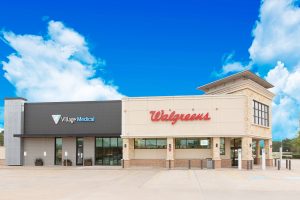
While site parameters may overlap harmoniously – both in terms of Walgreens fine-tuning square footage and VillageMD having a fleet of tailor-made spaces to grow into – the upside extends beyond that. Walgreens closed their own walk-in business clinic in 2019 in a savings effort, while CVS and their MinuteClinic maintain a daunting 52% share of the category. The new relationship with VillageMD helps recapture some of the traffic-driving potential from these services while back-end costs may have been untenable.
For VillageMD, they are proceeding with some additional peace of mind knowing that each facility will be created in a repeatable and consistent manner as they expand. Virtually all these new primary care clinics will also have an attached, full-service pharmacy. Combined, this allows them to better serve their patients’ needs.
Moving Off-Premise
While some mature organizations grapple with how to scale their existing footprints to align with the times, other brands are trying to chart a path for market growth that won’t be too much to swallow at once. And at the risk of turning that statement into a pun, this is especially magnified in the food and beverage categories.
Either through restriction or customer hesitation, the scale back of in-store dining has been a sea change for much of the industry. Carryout and delivery have brought needed business to many establishments. For those that weren’t previously set up for a revolving door of takeaway orders, this presented a whole new set of store planning, queuing, throughput, and even social distancing concerns.
The ghost kitchen trend preceded COVID-19 but has been catalyzed since its arrival based on some of these shifts. Rather than opening new facilities, restaurants can work with a third-party partner (i.e. Kitchen United) to lease kitchen space within a food service hub shared by other similar organizations. Orders can be received, prepared, and fulfilled in the same fashion as any other location, but the focus is primarily on delivery. Brands are afforded all of their back-of-house operations with minimal or non-existent costs regarding the front-of-house customer experience.
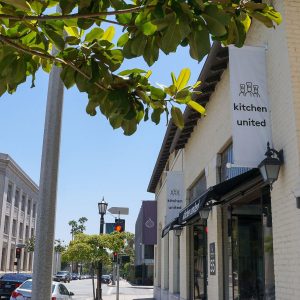
Full-service barbecue chain Famous Dave’s has over 120 locations across the country and had considered the ghost kitchen channel before the pandemic, but the seismic shifts in customer behavior and their workforce led them to open their first facility in Chicago this year. Fulfillment considerations aside, the more measured investment in the space has allowed it to be used as a testing ground for optimizing the brand’s menu, ordering process, and even their broader footprint considerations.
In recent years, premium Las-Vegas sandwich shop Capriotti’s began using ghost kitchens as part of their approach for new market entry. Currently, the brand has three ghost kitchens in operation – two in Los Angeles and one in Columbus, Ohio. Rather than being a vehicle to manage off-premise growth, these have served as components of broader plans to grow into those areas. By making the product available in new regions and marketing it appropriately, ghost kitchens have been part of the equation for creating softer ground to consider digging into in the future.
A recent Euromonitor report estimated that the ghost kitchen market could reach $1T globally by 2030. The United States has approximately 1,500 ghost kitchens across the country, compared to a whopping 7,500+ in China. Taken together with the shifts in customer behavior, there will certainly be more and more use cases to examine in the years to come, though ideally under safer circumstances.
Thinking Outside of the Retail Box
Beyond collaborations between brands and their landlord and developers, there have been some more direct partnerships with non-retail entities to help overcome some of the challenges of this past year. One such example has been XpresSpa’s since-expanded “XpresCheck” pilot program at JFK International Airport.
Certainly, XpresSpa is no stranger in American airports, offering on-the-go beauty treatments and neck massages across the country. When those services were deemed non-essential at the pandemic peak, operations had to halt. In parallel with their spas closing, there was an increase in the need for COVID-19 testing capabilities – presenting an opportunity to potentially repurposes some of that shuttered space.

Working with officials at JFK, XpresSpa converted one of their existing locations into a clinic. Supplemental space was even provided in the form of a modular addition to the Terminal 4 Arrivals Hall. This facility featured separate testing rooms capable of screening for both COVID-19 and antibodies, with the capacity to test up to 500 individuals daily. The concept was originally targeted at airline and airport employees but was expanded to passengers in August. It has since grown to additional sites, including Newark Liberty International Airport.
This type of clinical testing was a big departure from the norm for a health and beauty provider. Again, however, it’s an example of organizations turning unique challenges into potential opportunities through careful consideration of each party’s needs.
If negative tests become a contingent requirement for some international flights moving forward, airport authorities that moved early may be best positioned to manage screening and administration requirements. Efforts by XpresSpa and others to meet that need may become a large variable in that solution while supporting their own interests as a business enterprise as well.
Hopefully, as the calendar turns over, some of the more pandemic-specific considerations of these collaborations become moot points as the virus is defeated. If 2020 has been a brutal reminder of anything, though, it’s that we truly can never be sure of what’s coming around the corner. There will always be new challenges that can be overcome together.
Be You: Discover Your Style At COVERGIRL Times Square
At NELSON, our vision is to boldly transform all dimensions of the human experience. Our unique values fuel our culture and inspire us to constantly evolve and innovate. In celebration of our values, over the next few weeks, we’ll be highlighting the experiences that allow us to bring out the best in our teammates and clients. This week, we’re sharing how we have inspired others to BE YOU.
Our retail design team partnered with COVERGIRL to design and develop the brand’s first brick-and-mortar store located in the heart of Times Square New York City. Working closely with the cosmetic icon, our teammates created a fully immersive beauty destination where customers are encouraged to experiment and express themselves with their favorite products. Here’s the story:
Turning one of the city’s busiest street corners into a sleek cosmetic hub for the ultimate shared beauty experience, COVERGIRL’s first-ever physical store is dedicated to inspiring shoppers and embodying the brand’s “I Am What I Make Up” philosophy. Every detail encourages consumers to touch, test, and share—a playful and immersive experience that brings this iconic brand to life.
The store has allowed COVERGIRL to expand its offerings and for the first time, beauty enthusiasts have the opportunity to explore a three-dimensional version of the brand. Centering around product trial, dynamic features like high-end augmented reality glam stations were installed so that shoppers can digitally experiment and try on makeup to discover their personal beauty expression. A video booth allows customers to record videos set to music and capture photo ops to share on social media.
The finished space is a destination-worthy beauty playground that celebrates the brand’s confident essence and empowering spirit. While the design process included developing a glamourous space, the core of this project was about empowering young shoppers to discover their own style. The COVERGIRL store is more than a place to shop, it’s a place to BE YOU. As one of our core values, we couldn’t have been more honored to be a part of a project that allows one to express their unique self and actively connect with a community of authentic and diverse individuals.
[ngg src=”galleries” ids=”32″ display=”basic_thumbnail” number_of_columns=”3″]
Asset AdvantEDGE: Redefining Amenities
In recent years, physical amenities have become an imperative perk to differentiate your property’s experience, but the rise of COVID-19 has shifted consumer behavior and the role of the workplace (check out our post on Top 10 COVID-Safe Amenities). Soon, pressure for employees to return to the office full time will ease and it will be up to landlords to create a differentiated foundation for programming, engagement, and collaboration that tenants not only want to return to but cannot be replicated at home. The traditional definition of amenities will expand to support lifestyles – both in and outside the property – and successful future perks will be a blend of digital offerings and experiential environments, as our teammate Holly Williamson recently shared with the New York Real Estate Journal.
Download a PDF of this newsletter
Leading Regional Trends: Northeast | Southeast | Central | West
Good Reads | Featured Project
Northeast: Urban Convenience
Even post-pandemic, urban hubs in the Northeast will still value convenience in their workplace offerings. From secure bike rooms to commute-tracking apps, the focus will be on ease of experience, as much as safety. With public transit still a concern, offices should consider adding perks like an Uber allowance or electric scooter rentals for alternative transportation options. Landlords might even consider offering additional square footage in satellite buildings to give tenants and employees more flexibility in where they go to work, providing a dedicated network rather than a dedicated office. Consider conducting tenant surveys to understand your commute breakdown to provide more relevant offerings.
[ngg src=”galleries” ids=”9″ display=”basic_imagebrowser”]
Southeast: Foodie Focus
The foodie culture of the South will need to be reimagined in the wake of the pandemic. Landlords will need to get creative to offer a differentiated food and beverage experience for their tenants, with safety in mind. Consider win-win partnerships with local restaurants, food trucks, catering apps like Relish, and even cloud kitchens, to offer employees unique, localized food offerings in a more controlled environment. Create dedicated drop-off zones for food delivery with warming drawers, refrigerators, and disposable utensils to reduce touches and streamline the process.
[ngg src=”galleries” ids=”10″ display=”basic_imagebrowser”]
Central: All Season Entertainment
Now that tenants have been forced to embrace the working from home experiment, the role of the office is shifting. While heads-down work can easily be accomplished at home, the office will be need to be transformed into a social destination – an experiential hub for brands, dedicated to hosting clients, encouraging employee engagement, and facilitating teammate collaboration – and amenities will need to follow suit. Consider creating more elevated, year-round spaces that can flex depending on the occasion and get employees excited about an excuse to return to the office.
[ngg src=”galleries” ids=”11″ sortorder=”88,87″ display=”basic_imagebrowser”]
West: Wandering Wellness
A healthy lifestyle is nothing new in this region, but a renewed focus on holistic, outdoor wellness will reign supreme in the coming years. Create differentiated amenities like hiking trails, dedicated meditation areas, or artificial turf for multi-purpose events and activities, to allow your tenants to unwind and recharge in a safe environment. If you’re short on square footage, consider app subscriptions for on-demand content like Headspace, LulaFit, or Peloton.
[ngg src=”galleries” ids=”12″ display=”basic_imagebrowser”]
Working with you, to get you back to work
SPARC: Space Planning & Assessment in Response to COVID
As we collectively transition into the next phase of COVID-19 containment, we’re here to guide you through the process of assessing your space based on your company’s approach to returning to your workplace. Our tiered service packs allow you to quickly assess your needs and identify what’s right for you.
Good Reads
- 10 COVID-Safe Building Amenities
- Reimagining amenities for the future of workplace
- LulaFit adjusts to coronavirus crisis by shifting to virtual amenities programs
- The best workplace amenities are the ones your employees don’t even notice
- Food is a big deal at work. Here’s how the pandemic will change lunch and snacks
- A place to meet, a place to relax: what members want from their workspace
- Fitbit rolls out ‘Ready for Work’ COVID-19 symptom tracker
- The amenity evolution
- The future of work is hybrid: Work from home and the workplace
- The amenity effect: making your office building more marketable
Featured Project: Nomad Tower
We reimagined this 39-story building in New York City’s upcoming neighborhood known as NoMad, located north of Madison Square. Elevated amenity spaces including a private lounge complete with ping pong, pool table, and arcade games. In addition, tenants can take advantage of a conference room, 200-person amphitheater, fitness center, private coffee bar, and New York’s largest bicycle storage and bicycle access to an office building.
[ngg src=”galleries” ids=”13″ display=”basic_thumbnail” override_thumbnail_settings=”1″ thumbnail_width=”200″ thumbnail_height=”200″ thumbnail_crop=”1″]
See full project details View Asset Strategy
Return to Work Survey
Evolving Workforce Expectations
Learn more about NELSON Worldwide’s proprietary research study on emerging employee expectations to better determine the impact COVID-19 has had on work environments and employee engagement. We uncover insights that will help drive your re-entry strategy and provide support and context for future decisions.
Stay In the Know
The Amenity Effect: Developing a Live-In Lifestyle Destination
Amenities have a profound effect on the value of a building, and new unique experiences make a lasting impression for consumers, employees, hotel guests, and residents. Our mixed-use teammates set out to explore current and future amenity trends in our latest blog series, The Amenity Effect. Follow along as we dive deep into the environments where we work, shop, live, and thrive and take a closer look at the amenities that help make these environments flourish.
___________________________________________
For years there has been a battle between multi-family and residential developers on who can offer the best of the best when it comes to amenities. While the competition is still strong today, many have realized there is a pendulum that swings and what was magnetic to tenants a few years ago, may not carry the same allure today. Adding more truth to this idea, the changes that 2020 has brought upon our lives has allowed us to recognize the importance of our human condition and evaluate the instinctual needs to strive for providing good design accommodation. Across the residential sector, there has been and will continue to be a desire for experiential amenities. Here are four trends we see quickly approaching:
Outdoor Connectivity
During COVID-19 we’ve seen many people seek work-life balance with the outdoors including walks, patio Zoom calls, and creative exercising. Connectivity to greenways, parks, and trails when available are perks for those seeking that balance.
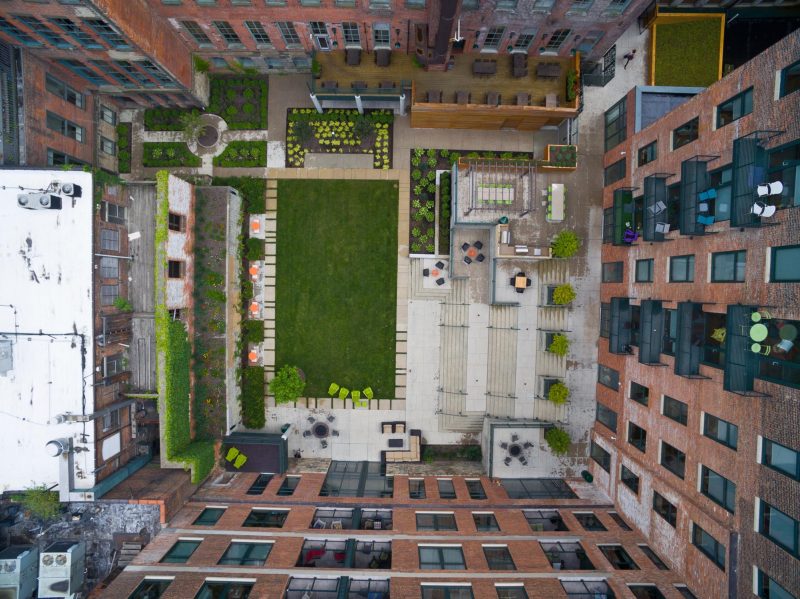
Worthington Yards | Cleveland, OH
As the desire for outdoor wellness grows, many tenants will look for developments that feature exterior amenities. Rooftops, pools, fire pits, and grills will continue to be favorites and moving forward we will see a desire for larger green spaces that can be segmented into smaller group spaces for yoga, respite, work, and appropriate social gatherings. In addition to this, attention to pets and gardening have also up ticked. Amenities such as dog washing stations, pet friendly courtyards, trails, and sustainable gardening will see a higher demand; especially today as the pandemic has resulted in an increase of pet adoption and less trips to grocery stores.
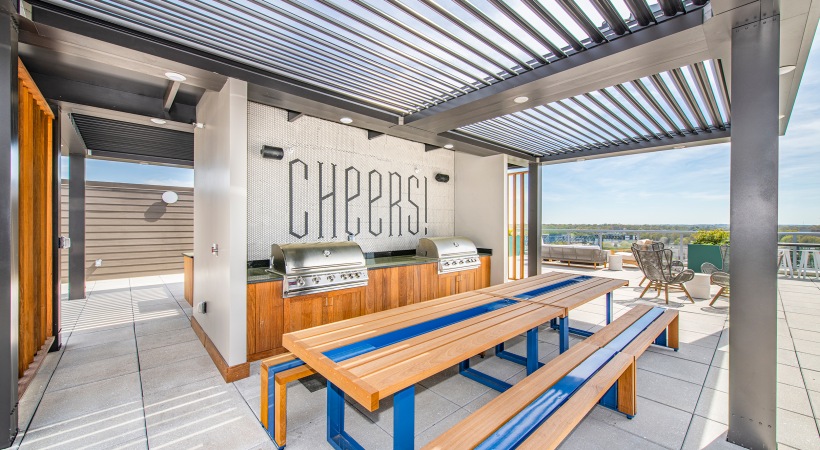
DECA Camperdown | Greenville, SC
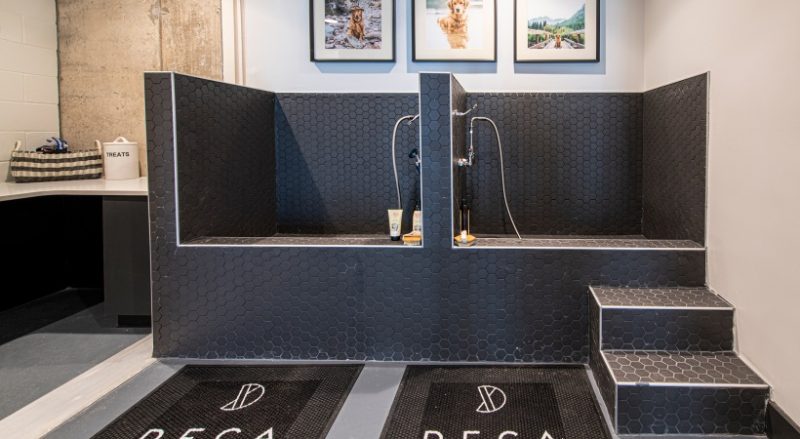
DECA Camperdown | Greenville, SC
Fitness
Fitness is a very powerful cog in the amenity wheel, whether communal or in-unit. At home fitness has increased dramatically in the absence of gyms during COVID-19, but private fitness spaces and outdoor equipment are still elements potential tenants desire.
Another fitness focused amenity developers may consider is bike maintenance programming and storage spaces. To avoid mass transit and increase outdoor time, many people have turned to bikes for fitness and transportation leading to opportunities for an enriched experience in how we transport bikes within a property.
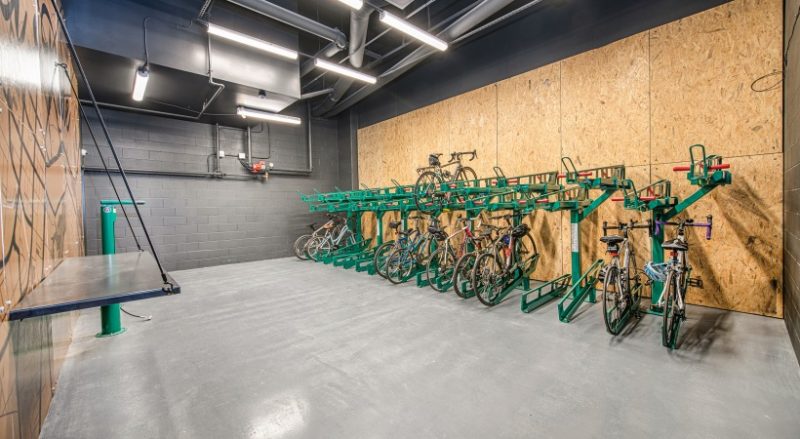
DECA Camperdown | Greenville, SC
Coworking
Coworking spaces are a growing trend in multi-family residential environments that will continue to increase as businesses adopt more permanent work-from-home policies. Media and conference rooms, as seen in our DECA Campertown project, are popular along with a variety of space types that provide for a heightened way we can experience work without having to travel to the traditional office. Developers are also looking to allocate square footage within units for individual private workspace.
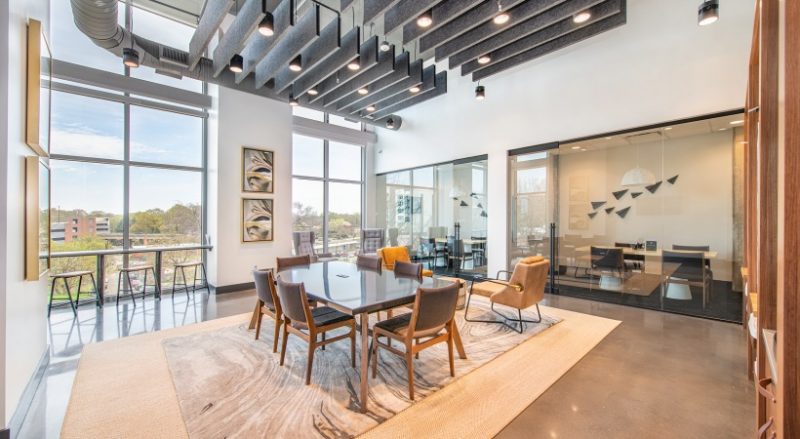
DECA Campertown | Greenville, SC
Community
Community is a big draw to multi-family and embracing the local context and history through brand and storytelling can reinforce the connection of street level amenities through branded storytelling. Restaurants, dry-cleaning, grocery, and other service retail help support residents as well as activate the ground floor. Designing the right mix and scale will allow fruitful and safe social engagement, while providing the comfort of home.
_______________________
“In these unprecedented times, where people are trying to maintain
a safe distance from one another, the human experience is still a social one.
By nature we crave a sense of togetherness and community.
Amenities help to provide an avenue to foster this need and can bring people together,
whether for work or play. It is our responsibility as architects and designers
to provide this environment in a safe, yet fun and exciting way.”
-John Lewis | NELSON Worldwide Studio Director, Multifamily
_______________________
Adding a sense of community to a development can be done in many ways, but one way we see this being done is through partnership with local art organizations. By adding installations and galleries throughout the building, as seen at Worthington Yards in Cleveland, OH, tenants are inspired to celebrate the space, its art, and community around them. Layering on a programming element allows for refreshed curation of new work and resident participation to provide new experiences with this type of cultural amenity.
Enhancing the experience of parcel pickup will be important to bring these community needs to the residents. Thoughtful design toward cold storage should be considered for the future of grocery, restaurant, and pharmaceutical deliveries.
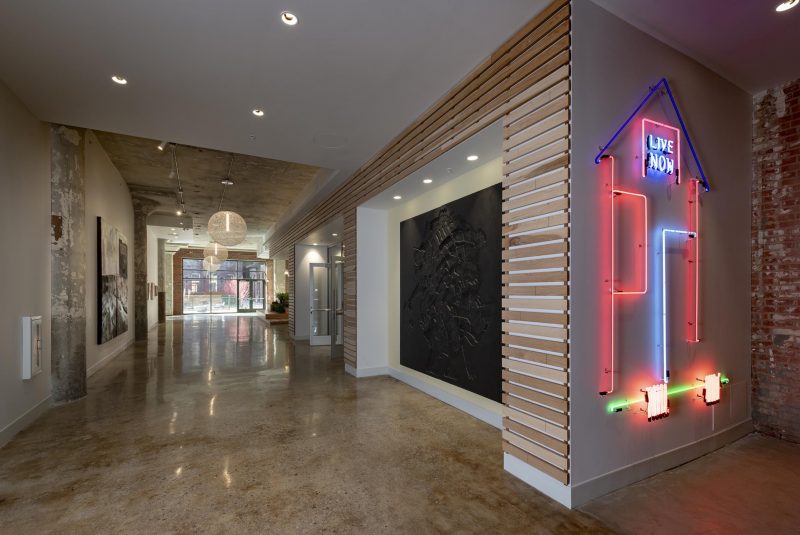
Worthington Yards | Cleveland, OH
_______________________
“In today’s emerging generations and onset of wellness heightened by COVID-19,
amenities are a basic requirement. We need to be asking ourselves,
how can we make the gym, cafeteria, outdoor deck, and beyond better?
We should be striving for ‘experiential’ design that takes these and turns
them up a notch to provide an experience.”–Haril A. Pandya, FAIA LEED AP | NELSON Worldwide, Sr. VP/Managing Director, National Practice Leader
_______________________
The amenity effect for residential developments goes beyond making a desirable place to live. Providing elements of convenience, community, and wellness are tools that create an environment that allows people to thrive and build a new lifestyle.
NELSON Worldwide Embraces Future of Work in New Minneapolis Office
MINNEAPOLIS – June 4, 2024—Award-winning architecture, design, and strategy firm NELSON Worldwide is thrilled to announce it has moved into its brand-new office space located at 901 S Marquette Avenue in Minneapolis, MN. This move underscores NELSON’s unwavering dedication to downtown Minneapolis, clients, and team members as well as its investment in a more flexible, innovative, and wellness-oriented workplace.
Leveraging their extensive workplace expertise, the team at NELSON Worldwide has designed a dynamic workplace that sets a new standard for modern offices. Leaving their previous office location of over 15 years, the team embraced the opportunity to create a space that reflected the current workplace landscape, its current needs, and future growth. Standing tall in Minneapolis, the 464-foot tower has undergone significant repositioning by the NELSON Worldwide team. Because of their connection and history with the building, NELSON strategically chose this development as the location for their new office. The team made use of a NELSON-designed customizable spec suite made available by the 901 Marquette Building client so they could devote 6-8 months to meticulously design and build the new offices located on the 28th floor – with outstanding views of downtown Minneapolis.
The new office, with its reduced footprint from 14,900 to 6,900 sq.ft., is designed to enhance employee collaboration and invigorate the work experience. An inviting welcoming zone greets teammates and guests upon arrival, an open area that combines residential comfort and hospitality elements to create a multipurpose front-of-house space that can accommodate one-on-one interactions as well as larger meetings. The new office seamlessly integrates spaces for chosen collaboration, including two Zoom rooms, a right-sized standard conference room, and a lounge-based corner conference room overlooking the Minnesota Twins Ballpark. The office also offers several central gathering areas for teamwork, emphasizing open, engaging environments for client and team interactions.
Central to the office’s design is its adaptability to NELSON’s forward-thinking hybrid work policy. With a focus on flexible furniture, enhanced technology infrastructure, and well-equipped individual workstations, the new office ensures that teammates can seamlessly transition between remote and in-office work, fostering a culture of innovation and collaboration regardless of physical location.
“This relocation and downsizing of our Minneapolis office highlights our dedication to crafting a space that aligns with our present requirements and future aspirations,” says Scott Hierlinger, Principal and Market Leader at NELSON Worldwide. “The office embodies our hybrid work style and caters to our in-office employees and client engagements.”
NELSON’s Minneapolis office exemplifies the firm’s commitment to excellence and innovation. It pilots new design concepts and reinforces the firm’s presence as a leading architecture and design force in the vibrant Minneapolis community.
The Amenity Effect: Making your Office Building More Marketable
Amenities have a profound effect on the value of a building, and new unique experiences make a lasting impression for consumers, employees, hotel guests, and residents. Our mixed-use teammates set out to explore current and future amenity trends in our latest blog series, The Amenity Effect. Follow along as we dive deep into the environments where we work, shop, live, and thrive and take a closer look at the amenities that help make these environments flourish.
___________________________________________
When I graduated from Oregon and moved to San Francisco to begin my career in architecture, it was at the peak of the dotcom era. Every other person I met was working for a startup of some sort with stories of ping pong tables, open refrigerators, drink carts, and skateboards in their offices. The dotcom parties we attended were epic with each startup trying to outdo the next, as the city was breeding a culture of having fun at work. Elementary school kids were trading in the vision of becoming a doctor or lawyer for a job at Google because of the perks that it came with. Corporations took note and began adopting the fun at work mentality, by saturating their office buildings, headquarters, and corporate campuses with amenities.
When it comes to workplace amenities, there isn’t just one magic formula. Developers and landlords can get creative with the route they want to take, but what matters most, is incorporating brand-centric amenities that complement the surrounding community and overall purpose of the building.
Here are three examples of different approaches to building amenities and their effect on the value of the facility:
1. Multi-tenant building with a central amenity hub
Some savvy developers have seen opportunities to acquire multi-building commercial office parks with little to nothing in common and transform them into campuses like those corporate and tech headquarters. They recognized the trend for hospitality inspired environments in universities that are nurturing our future workforce and the need to provide comparable environments in the real world. Sure each building could be outfitted with its own checklist of amenities, but these developers are aspiring to bring the multi-tenant buildings together with a centralized amenity hub.
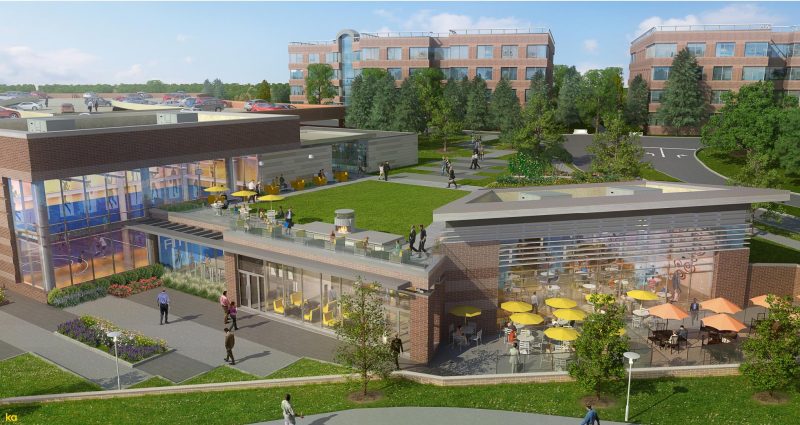
Warren Corporate Center – Warren, NJ
Warren Corporate Center in Warren, New Jersey is an example of a suburban multi-building, mixed tenant property that we helped reposition as a unique amenity-rich campus with dining, fitness, sports, conferencing, and workplace wellness offerings. NELSON capitalized on a central location for the amenity building, creating strong indoor-outdoor connections through transparency. The push and pull of building forms encourages visitors to wander into the building and explore the green roof plaza and views inside and out. A variety of gathering spaces offer visitors a new level of hospitality and reasons to stay longer for group meetings, individual work sessions, or corporate functions. The design elevated the quality of architecture and amenity space with the objective of attracting better tenants and encouraging current tenants to engage with a campus community.
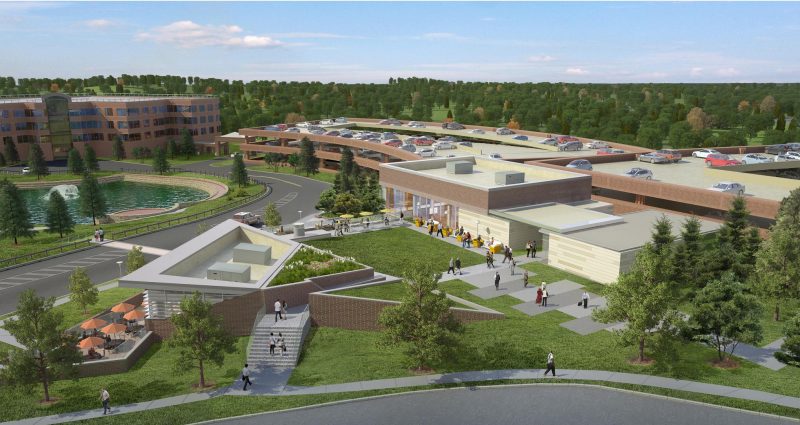
Warren Corporate Center – Warren, NJ
2. Social hub for wellness, collaboration, and after-hours activity
There are also opportunities to expand upon the more traditional fitness, conferencing, and dining amenities by positioning a facility as a social hub for wellness, collaboration, after work happy hours, and sports leagues.
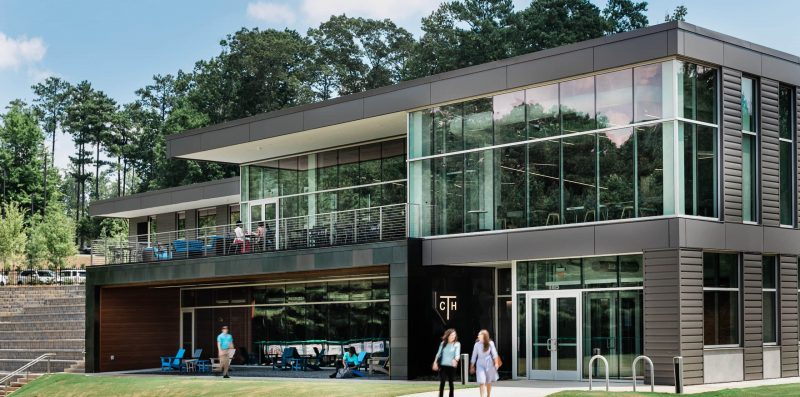
Sanctuary Park – Alpharetta , Georgia
Our approach in Alpharetta, Georgia was to position a new two-story building into the existing hillside to take advantage of the topography and maximize views to the natural surroundings and very active softball field. A terraced amphitheater provides both space for softball spectators, as well as causal seating and open-air meetings. Dining, lounging, and recreation spaces were arranged along a grand outdoor terrace that overlooked the ballfield, with all-glass walls to reinforce indoor-outdoor connections and provide natural light and stunning views throughout. A well-equipped fitness center is tucked into the lower level which features a high-end cardio and weight gym, classrooms, and spa-like locker and shower facilities to fulfill the cornucopia of centralized campus amenities.
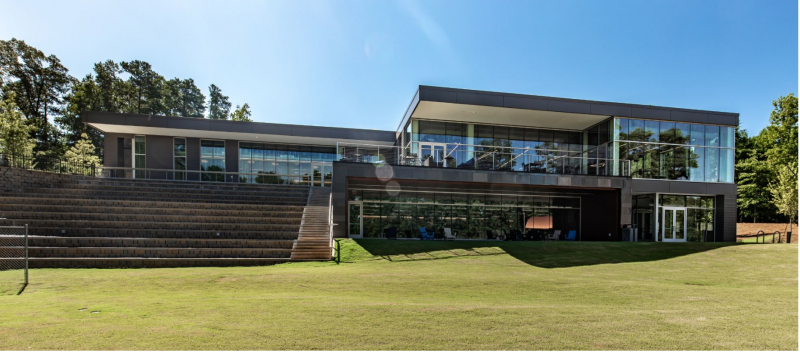
Sanctuary Park – Alpharetta , Georgia
3. Storied destination with outdoor and local flare
Storytelling can be a huge influence for leasing and attracting a tenant who seeks to provide an authentic environment for their employees. Adding outdoor elements and local flare can also add value. As crowded fitness centers, classrooms, and cafes hit pause for a while post-COVID-19, and more people continue to work from home, it will be necessary to provide a safe work environment.More thought and effort should be focused to evolving and merging the physical confines of a structured building with the fresh openness of the outdoors. Trails, walking paths, bike share programs could couple with covered outdoor working opportunities. Perhaps extended stay hospitality will make its way to these amenity buildings in the form of on-campus micro-suites that could provide for safe and convenient overnight stay and work opportunities for traveling employees, consultants and clients. Wherever the amenity game leads us, we as designers, owners and developers can seek to provide a blended biophilic connection of comfort, privacy, flexibility, inspiration, and efficiency in the way we work.
Latitude in Parisspany, New Jersey is an example where proximity of the existing buildings to I-80, helped inspire our branding and design teams to adopt a metaphor of coast-to-coast connectivity and the American landscape in the branding and design of the renovation. The main focal element of the project was the glass-enclosed space that would connect the two separate buildings to create a figurative crossroad for the entire property. A grand stair in the space responds to the site’s topography, reinforces outdoor connections, and provides the defining social gathering space for the campus.
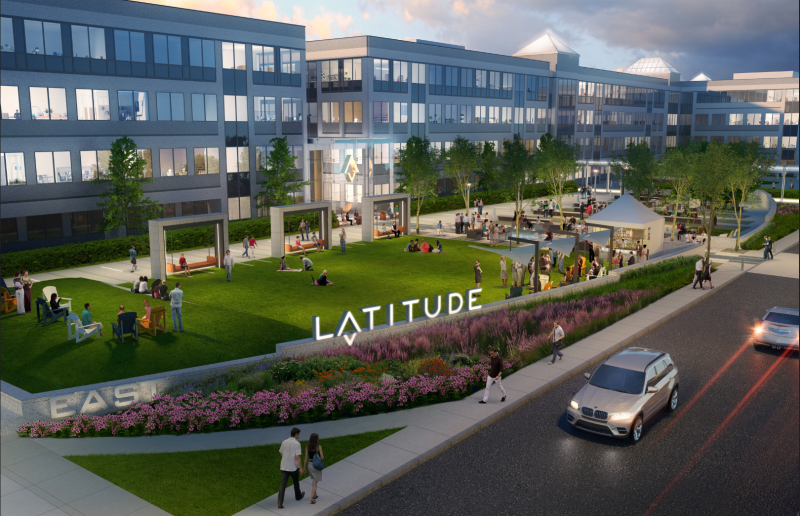
Latitude – Parsippany, New Jersey
The underutilized, long, linear landscaped area along the buildings has been re-imagined as a variety of outdoor amenity spaces that reinforce the coast-to-coast concept with elements that reflect vernacular imagery from across the country and offer options for events, recreation, individual reflection, spontaneous interactions, and collaboration.
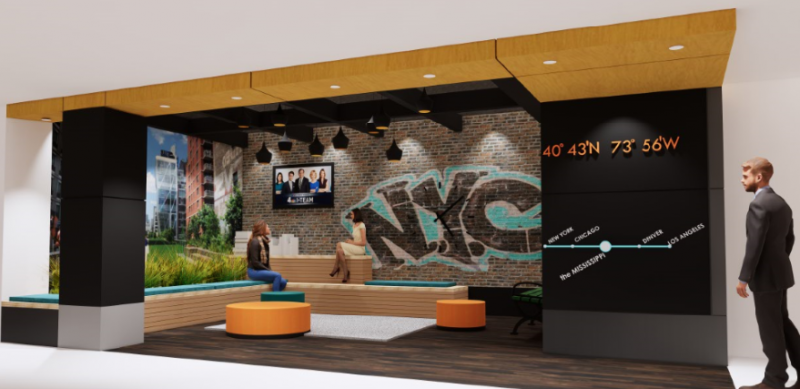
Latitude – Parsippany, New Jersey
The amenity effect for workplaces goes beyond recruiting and retaining employees. Whether a space is meant to connect tenants and inhabitants, inspire wellness and socialization, or tell a brand’s story, amenities are the valuable tools that grab attention and keep people coming back and engaged while they’re there.
What grocery, restaurant brands, and consumers are learning from COVID-19
Transformational shift in consumer lifestyle habits and retailers’ brand experience
First of all, THANK YOU to all the front line workers, including those at grocery stores and restaurants at this unprecedented time. You have provided all of us with the opportunity to be able to enjoy food and meals with our loved ones and families during this difficult period. Your efforts don’t go unnoticed!
As I think about how the quarantine has changed consumers’ perceptions and lifestyles relating to many different areas of our daily life (work, education, shopping, entertainment, fitness, etc.), I thought I’d share a perspective on how this might impact the future for grocery retailers and restaurants. This time has changed our shopping habits, food delivery, meals with others, pick-up and on-the-go ordering and even the packaging of food and other products.
I know many consumers are leveraging technology, perhaps for the first time, ordering online or on their mobile phone, picking up in store, curbside and/or having it delivered. Prepared food brands like Blue Apron have grown 300 percent this past month (after losing almost 60 percent market value in 2019). Hello Fresh has grown 40 percent year-to date. DoorDash, Grubhub, and UberEats are growing once again after struggles with obstacles the past six months from restaurants based on their high commission structure.
For many, some of these experiences will be for the first time (new adopters) or for others who were already technology savvy, our current situation has forced them to do this more often. So, what habits will stick in the future? What will change or evolve? What perceptions have been created about brands and their response to all of this? Has this new norm been favorable or unfavorable?
Some retail brands have responded to the challenge well. Kroger recently launched a pick-up only location to make it easier for shoppers to get groceries while limiting customers’ potential exposure to the coronavirus. Panera Bread restaurants, like other fast-casual brands are offering groceries to order and food delivery. Other brands like Walgreens are leveraging their drive-thru to expand the usage beyond dropping off and picking up a prescription. What could other brands learn from this?
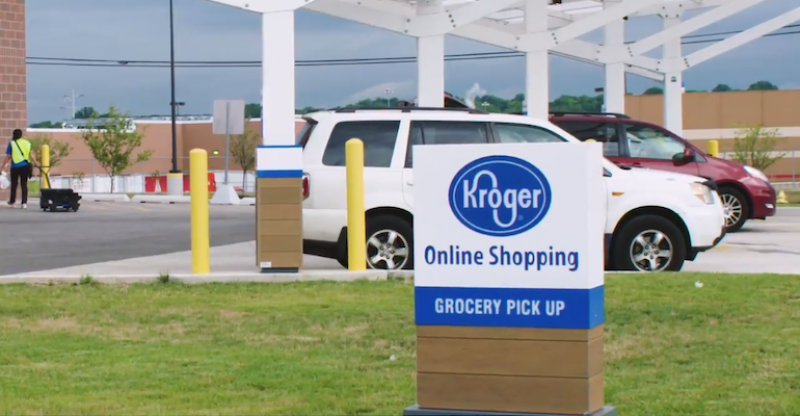
In the future, consumers will more than likely shift their purchase habits based on this recent experience. For example, because of the shortage of toilet paper, tissues, cleaning products etc., consumers have gone online to purchase these from retailers they would not normally consider. Many consumers already order staple items like these online via a replenishment program. In the future, will e-commerce grow even more rapidly because of this current experience where consumers feel more comfortable about this and actually enjoy it? I see many categories being affected by this, such as pet food, bulk beverages, and other items.
Brands will need to envision a new retail experience for the future in order to differentiate their brand proposition to remain competitive and to deliver on consumer trends.
This change will cause the need for a new supply chain model to be accelerated at a faster pace than what might have already been planned by some retailers. The role of the store will also need to continue to evolve. Transform the front-of-house and rethink the back-of-house to meet consumer demands and provide a more efficient distribution and delivery system. More efficient distribution centers are needed to facilitate the rise in e-commerce and delivery increase to stores and to customers. Many retailers will need a more efficient method, especially in urban areas for last-mile delivery, which will be important for retail brands to compete against Amazon and others.
Many consumer trends that were identified before the COVID-19 situation will not go away, but rather many of them will become accelerated, such as convenience, personalization/customization, integration of mobile/digital with the physical store experience, BOPIS destinations, etc. Convenience is a key area where many grocery and restaurant brands will need to rethink their offering. Since COVID-19 put restrictions for many restaurant and grocery brands in many states where they had to stop build-to-order food offerings (custom made sandwiches, meals, etc.), while still being allowed to sell pre-packaged food express/convenient offerings. In the future, both of these offerings will still be needed, although express/convenient offering will continue to grow. This affects the supply chain, delivery model and how this offer is presented or merchandised in store.
In summary, there are five key learnings in response to COVID-19 for retail brands:
- Rethink the supply chain for the new retail economy with a focus on a new channel for delivery providing more convenience for consumers while driving efficiency for the retailer.
- Transform the retail environment for shoppers – For grocery, how can the store become a destination for specific experiences, while strengthening their e-commerce business? For restaurants, how can they become more innovative with a retail offer in store, while innovating their to-go experience?
- Reimagine the role of the store – Transform the front-of-house and rethink the back-of-house to meet consumer demands and provide a more efficient distribution and delivery system.
- Leverage existing real estate assets and innovate to provide a better customer experience and differentiator for the brand – Parking lot, drive-thru, BOPIS destinations all can be reimagined.
- Integrate digital with the physical store – Innovate the consumer experience by providing meaningful mobile apps, RFID technology for the elimination of check-out and other processes, in-store communication and integration with mobile and other digital experiences.